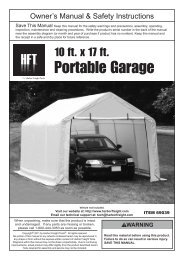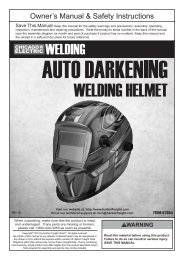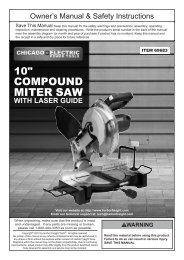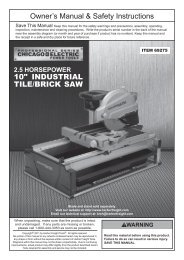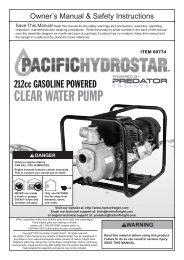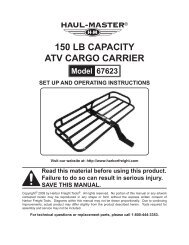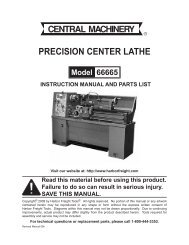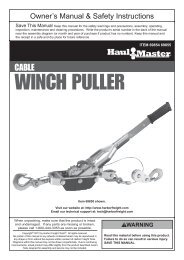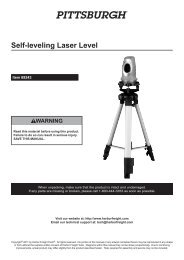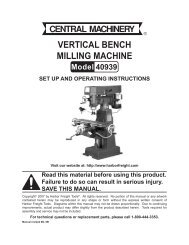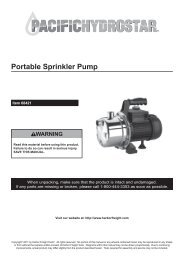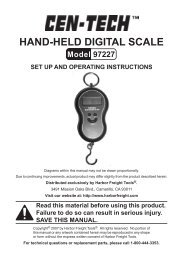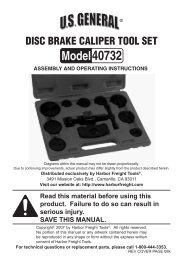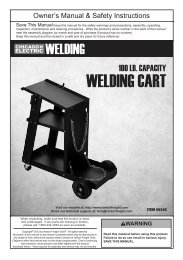power tool use and care - Harbor Freight Tools
power tool use and care - Harbor Freight Tools
power tool use and care - Harbor Freight Tools
Create successful ePaper yourself
Turn your PDF publications into a flip-book with our unique Google optimized e-Paper software.
Grounding<br />
SAFETy SETUp<br />
OpERATION MAINTENANcE<br />
TO pREVENT ELEcTRIc SHOcK AND DEATH FROM INcORREcT GROUNDING<br />
WIRE cONNEcTION:<br />
check with a qualified electrician if you are in doubt as to whether the outlet is properly grounded.<br />
Do not modify the <strong>power</strong> cord plug provided with the <strong>tool</strong>. Never remove the grounding prong from<br />
the plug. Do not <strong>use</strong> the <strong>tool</strong> if the <strong>power</strong> cord or plug is damaged. If damaged, have it repaired by a service<br />
facility before <strong>use</strong>. If the plug will not fit the outlet, have a proper outlet installed by a qualified electrician.<br />
Grounded <strong>Tools</strong>: <strong>Tools</strong> with Three prong plugs<br />
3-prong plug <strong>and</strong> Outlet<br />
1. <strong>Tools</strong> marked with “Grounding Required” have a three<br />
wire cord <strong>and</strong> three prong grounding plug. The plug<br />
must be connected to a properly grounded outlet.<br />
If the <strong>tool</strong> should electrically malfunction or break<br />
down, grounding provides a low resistance path to<br />
carry electricity away from the <strong>use</strong>r, reducing the risk<br />
of electric shock. (See 3-prong plug <strong>and</strong> Outlet.)<br />
2. The grounding prong in the plug is connected through<br />
the green wire inside the cord to the grounding<br />
system in the <strong>tool</strong>. The green wire in the cord must<br />
be the only wire connected to the <strong>tool</strong>’s grounding<br />
system <strong>and</strong> must never be attached to an electrically<br />
“live” terminal. (See 3-prong plug <strong>and</strong> Outlet.)<br />
3. The <strong>tool</strong> must be plugged into an appropriate outlet,<br />
properly installed <strong>and</strong> grounded in accordance with<br />
all codes <strong>and</strong> ordinances. The plug <strong>and</strong> outlet should<br />
look like those in the preceding illustration.<br />
(See 3-prong plug <strong>and</strong> Outlet.)<br />
Double Insulated <strong>Tools</strong>: <strong>Tools</strong> with Two prong plugs<br />
Extension cords<br />
Outlets for 2-prong plug<br />
1. Grounded <strong>tool</strong>s require a three wire extension cord.<br />
Double Insulated <strong>tool</strong>s can <strong>use</strong> either<br />
a two or three wire extension cord.<br />
2. As the distance from the supply outlet increases,<br />
you must <strong>use</strong> a heavier gauge extension cord.<br />
Using extension cords with inadequately sized wire<br />
ca<strong>use</strong>s a serious drop in voltage, resulting in loss of<br />
<strong>power</strong> <strong>and</strong> possible <strong>tool</strong> damage. (See Table A.)<br />
1. <strong>Tools</strong> marked “Double Insulated” do not<br />
require grounding. They have a special<br />
double insulation system which satisfies<br />
OSHA requirements <strong>and</strong> complies with<br />
the applicable st<strong>and</strong>ards of Underwriters<br />
Laboratories, Inc., the Canadian St<strong>and</strong>ard<br />
Association, <strong>and</strong> the National Electrical Code.<br />
2. Double insulated <strong>tool</strong>s may be <strong>use</strong>d in either of the<br />
120 volt outlets shown in the preceding illustration.<br />
(See Outlets for 2-prong plug.)<br />
3. The smaller the gauge number of the wire, the<br />
greater the capacity of the cord. For example,<br />
a 14 gauge cord can carry a higher current<br />
than a 16 gauge cord. (See Table A.)<br />
4. When using more than one extension cord to make<br />
up the total length, make sure each cord contains at<br />
least the minimum wire size required. (See Table A.)<br />
Page 6 For technical questions, please call 1-800-444-3353. Item 60610



